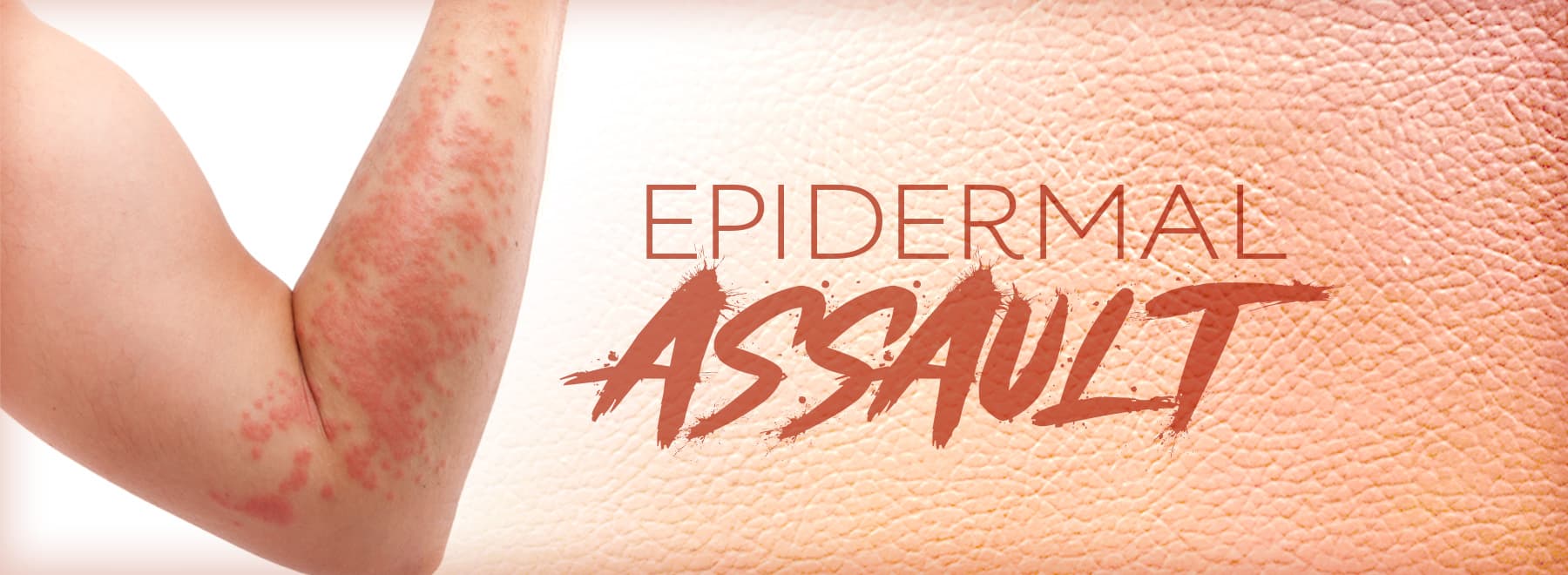From athlete’s foot to swimmer’s itch, how to soothe heat rashes
Picnics, swim parties, camping trips and hikes.
Poison ivy, swimmer’s itch, athlete’s foot and bug bites.
With summer comes a rash of outdoor activities that are fun, but they are often accompanied by rashes that are not – the kind that cause itchiness and pain.
Experts at the University of Mississippi Medical Center are offering advice on how to prevent heat-related assaults on your skin, and what to do if some slip through.

“A variety of skin conditions worsen in the summer months and in the heat,” said Dr. Chelsea Mockbee, assistant professor of dermatology at UMMC. “One of the most common is intertrigo.”
Intertrigo is a twenty-dollar word for an inflammation that crops up between the folds of skin.
“It can occur under the arms or breasts, on the abdomen or groin,” Mockbee said. “It’s exacerbated by heat and sweating. It’s chronic for some patients, but in the summer it can be harder to manage.”
To prevent it, or to realize a measure of relief once it occurs, wear loose-fitting clothing. Over-the-counter anti-fungal powders can treat it; these include clotrimazole and Zeasorb-AF, which can be effective against athlete’s foot.
Speaking of which, tinea pedis, or athlete’s foot, is an infection that usually begins between the toes. Sweaty feet squeezed inside tight-fitting shoes feeds the miserable effects of this fungus. And it’s particularly bad news if you have diabetes.
“[Athlete’s foot] puts people with diabetes at increased risk for cellulitis,” Mockbee said. With this bacterial infection comes red and swollen skin, most often on the lower legs. But cellulitis can pop up on the face, arms and other areas. If untreated, it can be life-threatening.
If you have a skin wound, it’s crucial for you to prevent a bout of cellulitis. That means taking antibiotics, washing the wound daily with soap and water, applying an over-the-counter ointment such as Vaseline, and bandaging the wound.
While we’re on our feet, let’s not neglect fungal infections of the toenail: Onychomycosis discolors and thickens the nail and separates it from the nail bed. Oral antifungal medications are used to treat onychomycosis, which is also more worrisome for people with diabetes due to the increased risk of cellulitis, Mockbee said.
More common in older patients, particularly older men, is Grover's disease.
“It classically presents with itchy red bumps on the chest and back and worsens in the heat,” Mockbee said.
For mild cases, physicians often treat it with topical steroid creams and anti-itch lotions.

Melasma is another condition more likely to manifest in his more mature patients, said Dr. Jarrett Morgan, assistant professor of medicine at UMMC, who has specialty training in both internal medicine and pediatrics.
Melasma’s mostly brown patches or freckled spots on the skin can occur during pregnancy, but hours spent in the sun or on tanning beds may increase your risk of this otherwise harmless disorder. Melasma, which may fade on its own, is difficult to treat, but there are ways, according to the American Academy of Dermatology Association.
While many skin conditions do pursue middle-aged and more elderly patients, children deserve a special mention in any discussion of skin conditions.
“In general, the younger the child, the more sensitive the skin,” Morgan said. “For children under six months, it’s recommended that they don’t get any sun exposure at all, and this is true for all skin types.
“If there has to be any sun exposure, apply a small amount of sunscreen to the child’s exposed skin. Keep them in the shade. In the car, use window covers. And make sure their clothing is loose-fitting. For children six months to adolescent age, always use sunscreen.”
That’s extremely important during the time of day when UV radiation is conspicuously high, around 10 a.m. to 4 p.m., according to the Environmental Protection Agency’s website. The recommended Sun Protection Factor is 15 to 30, and usually closer to 30, Morgan said. Read the label and make sure it provides UVA and UVB protection.
“Reapply it at least every two hours,” he said.
Some people should stay away from chemical sunscreens, Mockbee said. For certain patients, those concoctions can pose a risk for photoallergic contact dermatitis, an eruption that can be brought on by other substances as well, including certain medications. Instead, Mockbee said she generally prefers a physical sunblock, one with zinc oxide or titanium dioxide.
Beyond sunburn, swimmers, and especially bathers, risk other heat-related hazards. One of those is swimmer’s itch, a red, bumpy rash that usually torments areas of the skin that stay submerged.
“This happens not so much to people who use swimming pools,” Morgan said, “but it is more likely to affect those who use Jacuzzis shared by others.” Swimmer’s itch can even plague users of shared bathtubs, he said. Antibiotics can provide relief.
Another blight that thrives during sweltering weather is true to its name: prickly heat, or prickly skin.
“I see it in all age groups, but more so in the very young,” Morgan said. “It can be associated with blocked sweat glands, which can be caused by tight-fitting clothing.”
A heat rash look-alike is folliculitis.
“It looks like acne of the back and chest,” Mockbee said, “and is related to inflammation and infection around the hair follicle. You can treat it with an anti-acne-medicated benzoyl peroxide wash, which is over-the-counter. People who exercise a lot may be more prone to getting folliculitis.”
And people who live in Mississippi a lot are prone to getting bug bites.
“We see an increase in bug-bite reactions during the summer months,” Mockbee said. “We usually recommend a strong topical steroid for that.”
If you want to nip bite reactions in the bud, use bug repellent before going outdoors.
“We believe that bug sprays with DEET are the most effective,” Mockbee said.
When it comes to the bite of the poison ivy plant, though, there isn’t much you can do beforehand except stay away from it.
“The plant has three pointed leaves,” Mockbee said, “so we tell people, ‘leaves of three, let it be.’”
If you work outside, Mockbee and Morgan suggest wearing gloves and loose-fitting clothing and keeping your skin covered. If you see any suspicious leaves and believe you may have been exposed, wash your hands with soap and water immediately, Mockbee said.
Calamine lotion, Benadryl, Claritin, Allegra and other over-the-counter remedies may offer relief from poison ivy’s itch, Morgan said. If the reaction from the toxin is strong enough, you may need oral and/or topical steroids, Mockbee said.
And remember, in spite of what you may have heard, “you can’t catch poison ivy from someone else,” Morgan said. But he maintains you can catch it from substances on clothes and other personal items that have been in direct contact with the plant’s leaves.
You can’t catch eczema from someone else, either, but certain weather patterns can wreak even more misery on those who suffer from this skin condition. One of those patterns is a heat wave, which aggravates the itchiness.
A moisturizing cream can help, but a topical steroid, usually with a prescription, may be required in some cases, Mockbee said.
“Eczema can flare in hot weather, but also in the winter when skin is drier.”
Even so, as our Mississippi skins itch, sting, swell and blister in the sizzling cauldron of August, a bout of dry, cold weather is sounding pretty good right about now.
The above article appears in CONSULT, UMMC’s monthly e-newsletter sharing news about cutting-edge clinical and health science education advances and innovative biomedical research at the Medical Center and giving you tips and suggestions on how you and the people you love can live a healthier life. Click here and enter your email address to receive CONSULT free of charge. You may cancel at any time.



